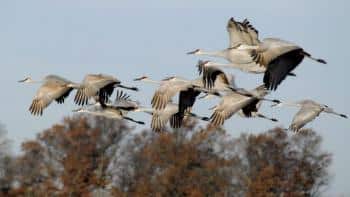Birds Face Migration Gauntlet

Sandhill Cranes
Photo credit: Jim Williams
by Val Cunningham
Contributing Writer
Restless birds are casting their eyes on the skies in backyards, parks, fields and woodlands.
Millions and millions of them are packing up and flying off to warmer places where they’ll spend the next six months. These include Ruby-throated Hummingbirds and House Wrens as well as Sandhill Cranes and Bald Eagles.
Birds don’t leave to escape the coming cold as much as to find food: many of our summer visitors could skip migration if they could find enough to eat, but winter locks away most food sources. So, the majority of Minnesota’s summer birds fly to places where insects, fruit and fishable waters are still abundant, hundreds or even thousands of miles to the south.
Tiny hummingbirds, who tip the scales at one-tenth of an ounce, travel up to 2,500 miles to reach familiar winter habitat, while warblers, some weighing less than half an ounce, might cross more than 4,000 miles to get to the tropics.
Birds are surely among the most intrepid creatures on Earth. When fall’s shorter days signal that it’s time to go, they head off on their long migratory gauntlet, so filled with hazards that only about half those that leave in autumn return in spring to claim breeding territories. Birds whose autumn migration takes them across the Gulf of Mexico must contend with hurricane season. This is on top of other threats all birds face, such as lack of refueling sites, predators and pesticide spraying.
Grueling marathon
Migration is a grueling marathon, but unlike human athletes, birds don’t go through a lengthy training period to build muscle and gain stamina. They do change their diet, switching from summer’s insects to meals heavy on fruits and grains, which convert quickly to energy-rich fat. Many of fall’s birds weigh half again as much as they did in summer and some hummingbirds pack on so much fat that they look like flying golf balls.
It’s no accident that just when birds need high energy food, shrubs and trees are rife with the berries and fruit that supply sugars and fatty acids. Songbirds such as robins, catbirds, Rose-breasted Grosbeaks and White-throated Sparrows are growing plump on grape, dogwood and viburnum berries. Plants supply the berries to entice the birds to fly off and disperse their seeds far and wide, surrounded by nitrogen-rich bird poop as fertilizer.
As our summer birds begin to disappear it would be reassuring to think of the youngsters, those hatched this year, flying with their parents down to Mexico, Panama or Brazil. But that’s not what happens, except in the case of cranes and flocking birds like Canada geese. Young songbirds must make their own way, using a map imprinted in their brains, and face each day’s perils alone. Next spring they’ll return along the same route, their map now augmented with visual cues, such as rivers and mountain ranges, to return.
Fall’s migrants do catch one break—they can take their time along the way, spending a few days or a week at sites offering abundant food. (Spring’s migrants, by contrast, are in a tearing hurry to claim prime breeding territories.)
By late October, most of our summer birds will be gone, except for that robin checking the platform feeder for fruit in December and the bluebirds gathered near a stream in January. We’ll have to wait until next April for the migrant majority to once again begin flooding into the state, a never-fail awe-inspiring event.
St. Paul, Minn., resident Val Cunningham. who leads bird hikes for the St. Paul Audubon Society and writes about nature for local, regional and national newspapers and magazines, can be reached at valwrites@comcast.net.



